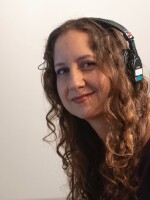The photographer Gary Monroe was in his early 20s when he decided he was going to go out and shoot photos in his neighborhood just about every day. He was in college in Tampa when it dawned on him that there was something very special about the neighborhood where he grew up, especially about the elderly Jewish people who had steadily moved there, some of them with numbers on their arms -- survivors of the Holocaust. The project went on for almost 10 years, between 1977 and 1986. Some of these photos are on display in an exhibition, "South Beach, 1977-1986," at the Patricia & Philip Frost Art Museum at Florida International University. Monroe and his photographs are also featued in the documentary film, "The Last Resort."
Monroe joined us on Sundial to talk about some of his photographs and why he took them. He'll be at the museum for a conversation about the project on Thursday, Aug. 29 at 3 p.m. The exhibition will be up through Dec. 8. You can read some excerpts from the conversation and listen to it here.
The following excerpt of the conversation has been edited for clarity.
WLRN: So I said that you shot photos of the neighborhood, but really you were taking photos of people who lived in South Beach. Who were they?
MONROE: They were the last leg of an Eastern European Jewry that made South Beach "the last resort." Growing up in South Beach, we didn't quite know what we had there, and back then South Beach was sort of an embarrassment to Miami. There were no young people; there were no clubs; it was just the opposite. But I had a sense when I went away to college [at USF in Tampa] that it represented a very precious legacy whose roots, of course, went back to czarist pogroms and the Nazi Holocaust, and this was the place where these Northeastern Jewish people found a community, a place to live and practice their religious mores and enjoy life to the fullest.

You shot in black and white. I'm really interested in where that decision came from, to shoot this incredibly colorful place in black and white.
It's probably personalities more than anything else, as well as an aesthetic judgment. Andy [Sweet] lived as sensationally as his photographs look. [Monroe and Sweet were close friends and photographed South Beach together; Sweet's photos are in vivid color.] And I prefer to be a little more behind the scenes and make photographs that are a bit more formalistically different, a different attitude toward the picture making process. I was restrained.
Light and shadow seem to play such important roles in your photography. There is a photograph of people who are just floating in the ocean, and the ocean takes up so much of the photograph.
Pre-1980, before the Mariel Boatlift, a group of elderly people, probably as many as 40 or 50 on certain days of the week, would walk down to 10th Street and Ocean Drive when it was still dark out. They'd enter the ocean before the sun would rise or as the sun was rising. And I would get up early and go down there at 6:30 also just to photograph that. But it was absolutely stunning to have these people just floating in the water. Young people have nothing on these elderly people who lived life with such zest and fulfillment. And that was what South Beach was all about. The photographs, I call them "Sunrise Swimmers," and it was a wonderful activity. But when crime soared in the early Eighties it vanished, like many things.
When you came back and you really made this commitment to the neighborhood as a photographer, did you know it [the time for the community] was fleeting? Did you know you were catching the end of something?
Yeah, I mean I knew they weren't going to be replaced by my generation of Americanized Jews. We're not the same. I knew that was the end of a very long lineage, and I thought it was really quite wonderful, and I felt very privileged to have found myself there.







